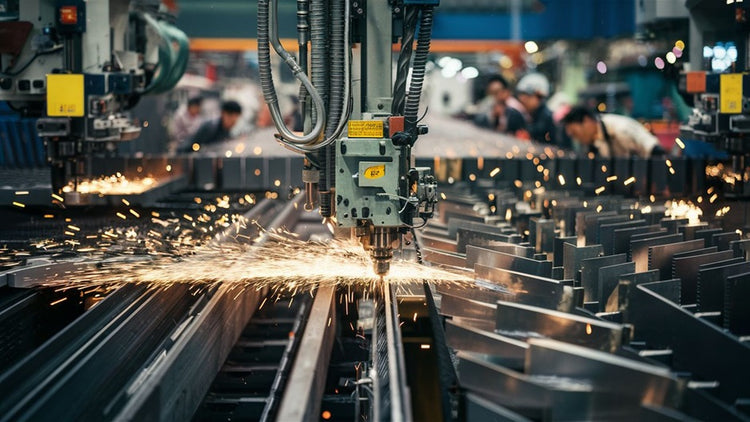6 Essential Steps to Selecting the Ideal Laser Cutting Machine for Business (Boost Efficiency & Slash Costs)

Selecting the ideal laser-cutting machine is pivotal for businesses aiming to enhance efficiency and reduce costs.
With the Chinese laser market expected to grow to $15.9 billion in 2024, the industry's rapid advancement underscores the importance of adopting the latest technologies [1]. Innovations such as laser-enabled 3D printing and smart lasers are transforming manufacturing, offering precision and flexibility.
For companies, investing in cutting-edge laser technology is not just about upgrading equipment; it's about future-proofing operations and seizing new growth opportunities.
This decision is crucial for businesses looking to stay competitive in a dynamic market.
This article will guide you through six steps to select the ideal laser-cutting machine for your business needs. From understanding your project requirements and budget to comparing features and warranties, we’ll help you make an informed decision that boosts efficiency and slashes costs.
Keep reading to find out how choosing wisely can transform your operations!
Key Takeaways
- Identify the materials and their thickness before choosing a laser cutting machine. This helps in picking a machine that matches your production needs without overspending.
- Assess the speed and precision of the laser cutting machine to ensure it can handle your projects efficiently. Machines with high automation levels save time and money.
- Choose machines with user-friendly features for easy operation, maintenance, and less training time for staff. This improves overall productivity.
- Check the after-sales support for maintenance and technical issues. Good support keeps your operations smooth, reducing downtime costs.
- Compare different machines' prices and warranty options carefully to find one that fits your budget while offering long-term value through efficient performance and lower maintenance needs.
Steps to Selecting an Ideal Laser Cutting Machine for Business
Selecting an ideal laser cutting machine for your business starts with determining your cutting needs and budget. Consider the type and thickness of materials, evaluate the speed and precision of the machine, look for user-friendly features, assess maintenance and technical support, and then compare prices and warranty options.
#1 Determine your cutting needs and budget
First, identify the materials you will cut with the laser machine. This step is crucial because different machines are built to handle various materials like metal, wood, glass, and ceramics.
Knowing the type of materials and their thickness is essential for selecting a machine with appropriate laser power and bed size. It ensures optimal performance without overstraining your budget.
Next, set a clear budget for your purchase while considering cost-effective solutions that do not compromise on quality. Budget planning plays a vital role as it helps in narrowing down choices to those within financial reach yet capable of meeting business productivity needs efficiently.
Keep in mind that investing in equipment with good speed, precision, and compatibility features can slash costs eventually and boost efficiency.
#2 Consider the type and thickness of materials

When selecting a laser cutting machine, consider the variety of materials that it can work with, including metal, wood, glass, ceramics, paper, and stones. Each material may require different settings and techniques for optimal cutting results.
Additionally, pay attention to the thickness of materials the machine can handle as this will affect its versatility in handling various projects. Understanding these capabilities is crucial in choosing a laser cutter that aligns with your production needs and goals.
Moving forward to evaluating - Evaluate the speed and precision of the machine
#3 Evaluate the speed and precision of the machine
Assess the machine's speed and precision to ensure efficient and accurate cutting operations. Consider laser power, cutting speed, and material compatibility for ideal performance.
The machine's level of automation significantly impacts efficiency and cost-effectiveness in production processes.
#4 Look for user-friendly features
When choosing a laser cutting machine, focus on user-friendly features that streamline operation and maintenance. Simplify the process by choosing machines with intuitive interfaces, automated settings, and easy-to-use software.
Consider accessibility for routine maintenance and troubleshooting to minimize downtime and enhance productivity. Keep in mind that user-friendly features can contribute significantly to operational efficiency and reduce training time for your staff.
Evaluate the ease of use when looking for a laser cutting machine, as this will affect daily operations and long-term maintenance. User-friendly features can make a substantial difference in achieving optimal performance while reducing operational disruptions.
#5 Assess the maintenance and technical support

Assessing the maintenance and technical support of a laser-cutting machine is crucial. Quality after-sales service and support from the supplier are essential for seamless business operations.
Ensuring that the equipment is well-maintained and is in a proper environment can significantly affect its performance and longevity, ultimately leading to cost savings and enhanced efficiency for manufacturers, designers, and engineers globally.
#6 Compare prices and warranty options
When considering a laser cutting machine, comparing prices and warranty options is essential. The cost of the machine, its efficiency, and the level of automation are essential in choosing the ideal equipment for your business.
Ensure to evaluate warranty options from different suppliers as it can affect long-term maintenance costs and operational support. Additionally, consider budgetary constraints alongside potential long-term savings through efficient operation and reduced maintenance needs.
Wrapping Up
Boost business efficiency and cut costs with the perfect laser-cutting machine. Consider your cutting needs, material types, speed, and precision. Look for user-friendly features, and consider maintenance and technical support.
Compare prices and warranty options to make the right choice.

